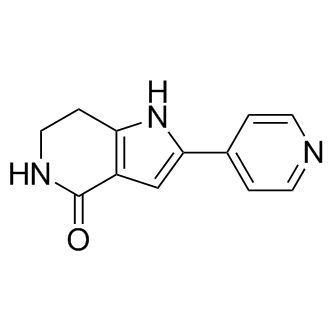| Cas No.: | 845714-00-3 |
| Chemical Name: | PHA-767491 free base |
| Synonyms: | PHA 767491,PHA-767491 |
| SMILES: | C1CNC(=O)C2=C1NC(=C2)C3=CC=NC=C3 |
| Formula: | C12H11N3O |
| M.Wt: | 213.24 |
| Sotrage: | 2 years -20°C Powder, 2 weeks 4°C in DMSO, 6 months -80°C in DMSO |
| Description: | PHA-767491 is a dual Cdc7/Cdk9 inhibitor, with IC50s of 10 nM and 34 nM, respectively. |
| In Vivo: | PHA-767491 decreases Chk1 phosphorylation and increases in situ cell apoptosis in tumor tissues sectioned from nude mice HCC xenografts[2]. |
| In Vitro: | PHA-767491 inhibits proliferation in both cell lines with an IC50 of 0.64 µM in HCC1954 cells and 1.3 µM in Colo-205 cells. PHA-767491 is effective DDK inhibitors in vitro, with IC50 values of 18.6 nM. PHA-767491 (2 µM) completely abolishes Mcm2 phosphorylation by 24 hours in HCC1954 cells[1]. PHA-767491 in combination with 5-FU exhibits much stronger cytotoxicity and induces significant apoptosis manifested by remarkably increased caspase 3 activation and poly(ADP-Ribose) polymerase fragmentation in HCC cells. PHA-767491 directly counteracts the 5-FU-induced phosphorylation of Chk1 and decreases the expression of the anti-apoptotic protein myeloid leukemia cell 1ine[2]. PHA-767491 (0-10 µM) decreases glioblastoma cell viability in a time- and dose-dependent fashion, with IC50 of approximately 2.5 µM for U87-MG and U251-MG cells. PHA-767491 hydrochloride induces apoptosis in glioblastoma cells, suppresses glioblastoma cell proliferation, cell migration and cell invasion[3]. |

 To enhance service speed and avoid tariff delays, we've opened a US warehouse. All US orders ship directly from our US facility.
To enhance service speed and avoid tariff delays, we've opened a US warehouse. All US orders ship directly from our US facility.




















